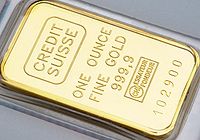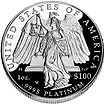
Troy ounce
Encyclopedia



Gram
The gram is a metric system unit of mass....
. There are approximately 32.1507466 troy oz in 1 kg. One troy ounce is equivalent to approximately 1.09714 avoirdupois
Avoirdupois
The avoirdupois system is a system of weights based on a pound of 16 ounces. It is the everyday system of weight used in the United States and is still widely used to varying degrees by many people in Canada, the United Kingdom, and some other former British colonies despite the official adoption...
ounces.
The troy ounce is part of the troy weight
Troy weight
Troy weight is a system of units of mass customarily used for precious metals, gemstones, and black powder.There are 12 troy ounces per troy pound, rather than the 16 ounces per pound found in the more common avoirdupois system. The troy ounce is 480 grains, compared with the avoirdupois ounce,...
s system, many aspects of which were indirectly derived from the Roman monetary system
Roman currency
The Roman currency during most of the Roman Republic and the western half of the Roman Empire consisted of coins including the aureus , the denarius , the sestertius , the dupondius , and the as...
. The Romans used bronze bars of varying weights as currency. An aes grave
Aes grave
Aes grave is a term in numismatics indicating bronze cast coins used in central Italy during the 4th and 5th centuries BC, whose value was generally indicated by signs: I for the as, S for semis and pellets for unciae...
weighed equal to 1 pound
Pound (mass)
The pound or pound-mass is a unit of mass used in the Imperial, United States customary and other systems of measurement...
. One twelfth of an aes grave was called an uncia
Uncia
Uncia can refer to:* Uncia , an ancient Roman bronze coin* Uncia , an ancient Roman unit of length* Uncia , a Bolivian tin mine...
, or in English an "ounce". Later standardization would change the ounce to 1/16 of a pound (the avoirdupois
Avoirdupois
The avoirdupois system is a system of weights based on a pound of 16 ounces. It is the everyday system of weight used in the United States and is still widely used to varying degrees by many people in Canada, the United Kingdom, and some other former British colonies despite the official adoption...
ounce), but the troy ounce, which is 1/12 of a troy pound (note that a troy pound is lighter than an avoirdupois pound), has been retained for the measure of precious metals. At 480 grains, the troy ounce is heavier than the avoirdupois ounce, which weighs 437.5 grains. A grain is 64.79891 milligrams (mg); hence one troy ounce is 31.1034768 gram
Gram
The gram is a metric system unit of mass....
s (g) (exact by definition), about 10 percent more than the avoirdupois ounce, which is 28.349523125 g (exact).
To maintain purity standards and common measures across time, the troy ounce was retained over the avoirdupois ounce in the weighing and pricing of gold
Gold
Gold is a chemical element with the symbol Au and an atomic number of 79. Gold is a dense, soft, shiny, malleable and ductile metal. Pure gold has a bright yellow color and luster traditionally considered attractive, which it maintains without oxidizing in air or water. Chemically, gold is a...
, platinum
Platinum
Platinum is a chemical element with the chemical symbol Pt and an atomic number of 78. Its name is derived from the Spanish term platina del Pinto, which is literally translated into "little silver of the Pinto River." It is a dense, malleable, ductile, precious, gray-white transition metal...
, silver
Silver
Silver is a metallic chemical element with the chemical symbol Ag and atomic number 47. A soft, white, lustrous transition metal, it has the highest electrical conductivity of any element and the highest thermal conductivity of any metal...
and gunpowder
Gunpowder
Gunpowder, also known since in the late 19th century as black powder, was the first chemical explosive and the only one known until the mid 1800s. It is a mixture of sulfur, charcoal, and potassium nitrate - with the sulfur and charcoal acting as fuels, while the saltpeter works as an oxidizer...
. Likewise, the grain, identical in both the troy and avoirdupois systems, is still used to measure arrow and arrowhead weights in archery
Archery
Archery is the art, practice, or skill of propelling arrows with the use of a bow, from Latin arcus. Archery has historically been used for hunting and combat; in modern times, however, its main use is that of a recreational activity...
along with projectile (bullet) and propellant (powder) weights in ballistics
Ballistics
Ballistics is the science of mechanics that deals with the flight, behavior, and effects of projectiles, especially bullets, gravity bombs, rockets, or the like; the science or art of designing and accelerating projectiles so as to achieve a desired performance.A ballistic body is a body which is...
. The troy ounce and grain were also common to the apothecaries' system
Apothecaries' system
The apothecaries' system of weights is a historical system of mass units that were used by physicians and apothecaries for medical recipes, and also sometimes by scientists. The English version of the system is closely related with the English troy system of weights, the pound and grain being...
long used in medicine, but have been largely replaced by milligrams.
Etymology
The name "troy" is first attested in 1390. Though it is often connected to a fair at the city of TroyesTroyes
Troyes is a commune and the capital of the Aube department in north-central France. It is located on the Seine river about southeast of Paris. Many half-timbered houses survive in the old town...
, France, this story may have been invented in the 18th century.
History
The troy ounce in use today is essentially the same as the British Imperial troy ounce (1824-1971), adopted as an official weight standard for coinage by Act of Congress on May 19, 1828.The British Imperial troy ounce (known more commonly simply as the imperial troy ounce) was based on, and virtually identical with, the pre-1824 English troy ounce and the pre-1707 English troy ounce. (1824 was the year the British Imperial system of weights and measures was adopted, 1707 was the year of the Act of Union which created the United Kingdom of Great Britain.) The English troy ounce was officially adopted for coinage in 1527. Troy ounces were used in the private sector in England since about 1400. Prior to that, various sorts of troy ounces were in use on the continent.
See also
- English unitEnglish unitEnglish units are the historical units of measurement used in England up to 1824, which evolved as a combination of the Anglo-Saxon and Roman systems of units...
- Imperial unitImperial unitThe system of imperial units or the imperial system is the system of units first defined in the British Weights and Measures Act of 1824, which was later refined and reduced. The system came into official use across the British Empire...
- Tola (unit)
- United States customary unitsUnited States customary unitsUnited States customary units are a system of measurements commonly used in the United States. Many U.S. units are virtually identical to their imperial counterparts, but the U.S. customary system developed from English units used in the British Empire before the system of imperial units was...

